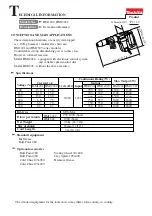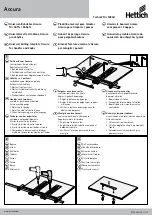
P a g e
|
16
OIPB-I03026-T2200PRO_v3.1
Harmful levels of CO are a potential danger to workers of: acetylene workers, blast
furnace workers, boiler room workers, brewery workers, carbon black makers, coke
oven workers, diesel engine operators, dock workers, garage mechanics, metal oxide
reducers, miners, organic chemical synthesizers, petroleum refinery workers, pulp and
paper workers, steel workers, toll booth and tunnel attendants, and warehouse workers.
3. What Are the Symptoms?
Large amounts of CO can kill in minutes. The more CO in the air and the longer you are
exposed to it, the greater the danger. Any one or more of the following symptoms can
signal CO poisoning: headaches, tightness across the chest, nausea, drowsiness,
inattention, or fatigue. As the amount of CO in the air increases, symptoms that are
more serious may develop such as lack of coordination, weakness, and confusion.
The poisoning can be reversed if caught in time. However, even if you recover, acute
poisoning can result in permanent damage to the parts of the body that require oxygen,
such as the heart and brain. There s a significant reproductive risk involved with CO. An
American Journal of Industrial Medicine article quotes two studies showing that acute
CO exposures that were non-lethal to the mother were associated with fetal loss.
4. What Can You Do About CO?
If you suspect CO, get out of the area and into the open fresh air. Remove anyone
overcome by the gas immediately and give the person artificial respiration. Call for a
doctor and continue the artificial respiration until the doctor arrives or the person
recovers. Prompt action can make the difference between life and death.
5. Employers
•
Install an effective ventilation system to remove poisonous CO from the area.
•
Maintain appliances and equipment in good order, adjusting flames, burners, and
drafts to reduce the formation of CO.
•
Consider switching from fossil fuel-powered equipment to battery-powered
machinery when possible.
•
Provide approved respirators for emergency use. Regular respirators (negative
pressure) will not work in this atmosphere. If necessary, provide an independent
air supply to workers.
•
Install CO monitors or regularly test air in areas when CO in generated or used.
•
Provide pre-placement and periodic medical examinations for workers who may
be exposed to CO. If possible, transfer affected workers to other jobs.
•
Inform workers of the hazards of CO and train them in the proper use of
respirators.
6. Workers
•
Report to your employer any condition that might make CO form or accumulate.
•
Be alert to ventilation problems, especially in enclosed areas where gases of
burning fuels may be released.
•
Report complaints early. Do not overexert yourself if you suspect CO poisoning.
Physical activity incre
ases the body’s need for oxygen, increasing the danger of
poisoning.
•
If you get sick, tell your doctor about the possibility of exposure to CO.
•
Think carefully about your smoking habits. Tobacco, when burned, releases CO
which reduces the oxygen-carrying ability of the blood even before any industrial
exposure is factored in.
Discount-Equipment.com
Содержание Innovatech Terminator T-2200PRO
Страница 20: ...P a g e 19 OIPB I03026 T2200PRO_v3 1 23 Parts List T2200 PRO Terminator D i s c o u n t E q u i p m e n t c o m...
Страница 26: ...P a g e 25 OIPB I03026 T2200PRO_v3 1 D i s c o u n t E q u i p m e n t c o m...
Страница 30: ...P a g e 29 OIPB I03026 T2200PRO_v3 1 D i s c o u n t E q u i p m e n t c o m...
Страница 34: ...P a g e 33 OIPB I03026 T2200PRO_v3 1 D i s c o u n t E q u i p m e n t c o m...
Страница 36: ...P a g e 35 OIPB I03026 T2200PRO_v3 1 D i s c o u n t E q u i p m e n t c o m...
















































